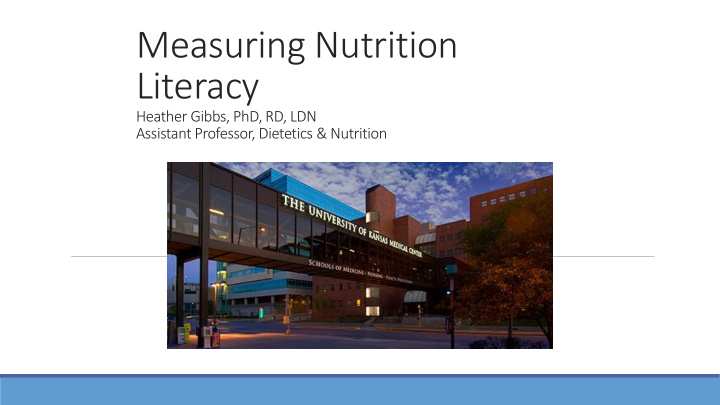



Measuring Nutrition Literacy Heather Gibbs, PhD, RD, LDN Assistant Professor, Dietetics & Nutrition
Audience Participation! Using 2- 3 words, describe “health literacy” To participate: 1. Text ‘heathergibbs494’ to ‘37607’ (to join) 2. Text your answer https://www.polleverywhere.com/free_text_polls/7xFXYdTly7hknGs
Prevalence of Low Health Literacy PERCENTAGE OF ADULTS IN EACH HEALTH LITERACY LEVEL: 2003 Proficient Below Basic 12% 14% Basic 22% Intermediate 52% US Department of Education, 2006
Associations of Low Health Literacy Decreased knowledge of illness and management Increased hospitalization rates Decreased use of preventive care services Increased cost of health care Neilson-Bowman, Institute of Medicine, 2004
Outcomes in Patients With Low Health Literacy Good Evidence Higher all-cause mortality rates of elderly persons Moderate Evidence Increased use of emergency care and hospitalizations Lower probability of mammogram screening and flu vaccinations Poorer skills associated with taking medications Poorer interpretation of medication or nutrition labels Poorer health status among elderly persons Note: Emerging evidence that health literacy may mediate racial disparities in health outcomes Berkman et al. 2011
Health Literacy and Food Label Reading Rothman, 2006
Health Literacy and Portion Sizing ½ cup cranberry 1 cup cooked ½ cup pineapple 3 oz cooked juice pasta ground beef Overestimation of a single food serving was more likely in those with low health literacy (p<0.001) or numeracy (p=0.008) Huizinga, 2009; public domain photos
Health Literacy and Eating Habits Zoellner , 2011
What is “nutrition literacy”? “the degree to which individuals have the capacity to obtain, process, and understand nutrition information and skills needed in order to make appropriate nutrition decisions” ◦ Conceptual nutrition knowledge ◦ Functional capabilities (skill) Silk, 2007
GENERAL HEALTH LITERACY NUTRITION RELATED Rapid Estimate of Adult Literacy in Medicine 1 Newest Vital Sign 4 (NVS) (REALM) Diabetes Numeracy Test 5 (DNT) Test of Functional Health Literacy in Adults 2 Nutrition Literacy Scale 6 (NLS) (TOFHLA) Critical Nutrition Literacy 7 Shortened-TOFHLA 3 1 Davis, 1993; 2 Parker, 1995; 3 Baker, 1999; 4 Weiss, 2005; 5 Huizinga, 2008; 6 Diamond, 2007; 7 Guttersrud, 2014
Development of a Measure of Nutrition Literacy (NLit) Interviews RD Critique Interviewed 8 2 Pilots nutrition Registered dietitians education Breast Cancer Patients: Validation critiqued the experts to Content experts & patient instrument via determine interviews; Instrument Nutrition related online survey instrument testing with 71 patients chronic disease (n=134-178) domains J Canc Educ , 2015 Parents of 4-6 yr olds: Prev Chronic Health, 2012 Data collection Disease , 2013 Instrument testing with completed May 101 dyads 2016 J Nutr Educ Behav, 2016
NUTRITION KNOWLEDGE NUTRITION SKILL Nutrition and Health Household Food Measurement Energy Sources in Food Food Label and Numeracy Food Groups Consumer Skills Goal Length: 6 items per domain (36 items total) Administered online or in print
NLit Example: Household Food Measurement Domain
NLit Example: Food Label & Numeracy Domain
NLit Example: Consumer Skills Domain
NLit Validation Study Aims 1. Revise the NLit based upon feedback from nutrition experts and members of the target audience (patients). 2. Evaluate the validity and reliability of the revised NLit.
Revision Process Cognitive Expert Content Item Development Interviews with Review Target Audience • ‘Energy density’ and ‘nutrient • Breast Ca Pilot Content density’ are difficult terms Validity Index = 0.93 • Actual portions consumed • Chronic Disease Content may be a reference if people Validity Index = 0.90 do not know recommended portions • Calculating % (food label application) was not attempted by some
Strength of relationships between instrument domains and diet quality Data for 71 breast cancer patients (17 primary prevention, 54 survivors) Gibbs, J Canc Educ, 2015
Nutrition Literacy is Related to Diet Quality 101 parent-child dyads Parent nutrition literacy assessed by NLit-P ◦ 42 items ◦ 5 domains Child (4.9 ± .7 yrs) diet quality assessed by Healthy Eating Index- 2010 score from 2, 24-hour recalls Every 1% increase in parental nutrition literacy = 0.51 increase in child Healthy Eating Index (R 2 =0.174, p<0.001) Gibbs, et al. JNEB, 2016
NLit Validation Initial Findings
Closing Thoughts Uses for nutrition literacy assessment: ◦ Research: tool for nutrition literacy identification ◦ Practice: identify deficits and determine educational messages ◦ Outcome measure for targeting improved nutrition literacy Efforts to improve diet quality may include improving nutrition literacy
Acknowledgements KUMC Research Team: Debra Sullivan, PhD, RD; Edward Ellerbeck, MD, MPH; Byron Gajewski, PhD; Christie Befort, PhD; Susan Harvey, PhD, CHES; Amy Kennett, MS, RD: Beth Kerling, MS, RD; Jocelyn Thodosoff, MS, RD; Sarah Owens, MS, RD; Katie George, MS, RD; Juliana Camargo, MPH; Jolyn Mortenson, MS, RD; Shelby Courtright, MS, RD University of Illinois: Karen Chapman-Novakofski, PhD, RD Research efforts supported in part by: • Eunice Kennedy Shriver National Institute of Child Health and Human Development (1R03 HD081730) • American Cancer Society grant (IRG-09-062-04), awarded to the University of Kansas Medical Center • Frontiers: The Heartland Institute for Clinical and Translational Research which is supported by a CTSA grant to the University of Kansas Medical Center from the NIH National Center for Advancing Translational Science (NCATS; grant # UL1TR000001)
Recommend
More recommend